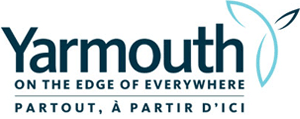INVASIVE PLANT SPECIES ALERT! Tansy Ragwort and Himalayan Blackberry gaining ground in Yarmouth
Communities in Bloom Yarmouth and the Southwest Nova Biosphere Reserve are advising Yarmouth residents about two invasive plant species that are becoming far too common in the area. The first is Tansy Ragwort, also known as "Stinking Willie". Tansy ragwort is a biennial (blooming the second year), but also can act as a perennial. It features bright yellow blooms, and can be seen just about everywhere in Yarmouth County this season. It looks similar to another wildflower called Solidago, known more commonly as “Golden Rod”, and often grows alongside it. But there’s a big difference between the two, as tansy ragwort is very toxic to livestock and other animals. In its first year, the weed appears simply as a rosette of leaves, and if not removed, becomes much larger with yellow blooming flowers in its second year (see photos). If you encounter this invasive plant on your property, proper removal can help reduce its spread. Each plant left to grow will eventually produce millions of seeds. Here’s how to safely remove and dispose of it:
- Mowing will prevent the plant from blooming and spreading seeds, but it will continue to regenerate.
- Fully remove the plant from the ground, making certain to pull the roots. Wearing gloves is a good idea, as many have found they are sensitive to the plant.
- Dispose of the removed plant(s) in clear garbage bags and place at curbside for pickup on your regular garbage day. DO NO COMPOST tansy ragwort, as the roots and seeds could survive the composting process and continue spreading.
The second invasive species is not toxic, but is very difficult to remove once it takes root on your property. The Himalayan Blackberry found its way to Yarmouth in the 1970's. This species is very different from native blackberry plants, forming extremely dense thickets with extra-large, curved thorns. The plant spreads through seeding, but also through growth of its extra-long branches. Each time a branch touches the ground, a new plant often grows in that spot. Himalayan blackberry blooms later than native blackberry, and has blooms that are white to pink. Identifying this plant early is key to preventing it taking over an area of your property. If you spot this species, do the following:
- Wearing gloves and protective clothing, carefully cut down the canes. This plant is not likely to survive composting, so it is safe to place in your compost/green cart.
- Once the canes have been removed, go to work on removing the roots if possible.
- Continuous mowing of the canes is another way to keep the plant in check.
Southwest Nova Biosphere Reserve representatives are expecting a management plan on Himalayan Blackberry from the Invasive Species Council of Nova Scotia. Details from that plan will be made available at a later time.
For more advice and information about these invasive plants, as well as other plants to keep an eye out for on your property, please email info@swnovabiosphere.ca
Monthly FYIs September & October
Upcoming Council Meetings
You can watch regular town council meetings live on Eastlink Community TV, or through our livestreaming service. Committee of the Whole council meetings are available through livestream only. You can find meeting agendas and livestreaming details on our website at www.townofyarmouth.ca/ agenda-and-minutes-livestream.html
o Committee of the Whole Council Meeting Thursday, September 22nd, 3:30 pm
o Regular Town Council Meeting Thursday, October 13th, 6:30 pm
Notice of Public Consultations: Municipal Boundary Review
As part of the Municipal Boundary Review process, each municipal council in the province is required to conduct a study every 8 years of the number and boundaries of polling districts in the municipality, their fairness and reasonableness, and the number of councillors. The last review was carried out in 2014, and the Town of Yarmouth is now required to conduct a new Municipal Boundary Review.
As part of the public engagement process, we conducted a survey, and received valuable feedback. For part two of our public engagement process, we are hosting two public consultation sessions to share the survey results, receive more of your feedback, and answer any questions you may have about the boundary review. Please join us On Thursday, October 13th in council chambers at Yarmouth Town Hall, 400 Main Street. There are two times to choose from: 12 pm – 1 pm OR 5 pm - 6:30 pm. See you then!
Employment Opportunities
The Town of Yarmouth is seeking to fill the following positions:
Grants Coordinator
Reporting to the Town Engineer, the Grants Coordinator will be responsible for researching, preparing, submitting and managing grant applications to secure funding on behalf of the organization.
Transit Drivers (Casual)
We are seeking to fill casual bus driver positions. Applications should include a copy of your Class 4 license, Drivers Abstract, Criminal Record Check. You will be required to submit a Vulnerable Sector Check if successful in the interview process
Water Treatment Plant Operator
This role involves water treatment facility operational duties, as well as duties related to the monitoring of the water quality, in the facility, in the distribution system, and in the watershed, as assigned by the Chief Operator.
Wastewater Treatment Plant Operator
This position involves wastewater treatment facility operational duties related to the safe and efficient operation of the Yarmouth Wastewater Treatment Plant.
For full details on these positions and to apply, visit: townofyarmouth.ca/news-notices/employment-opportunities/

